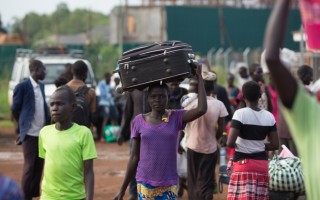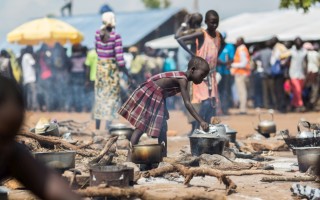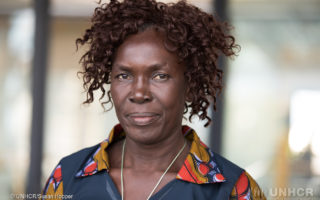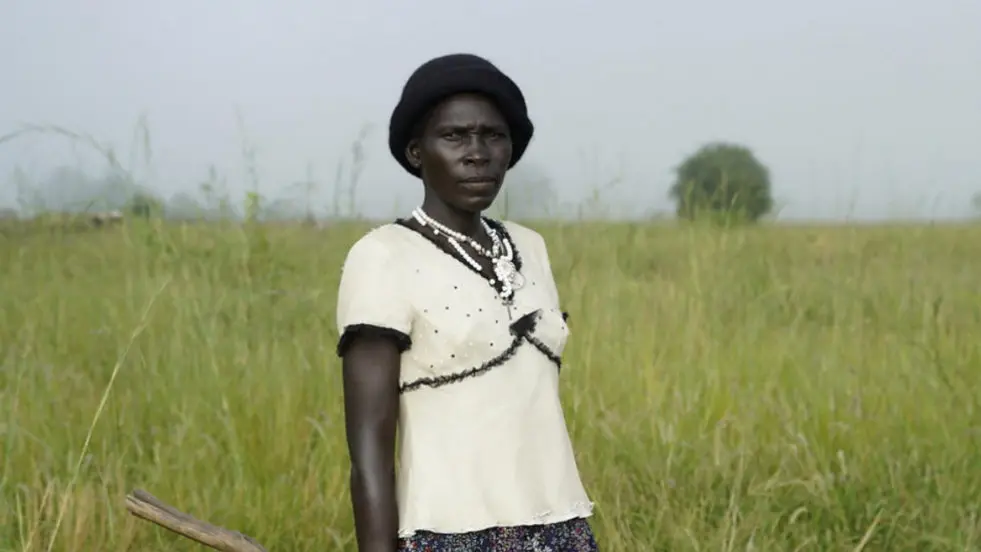
Thanks to generous neighbours, South Sudanese refugee Queen Chandia grows rice and other crops in Uganda. © UNHCR/Michele Sibiloni
A programme to promote rice production is bringing refugee and local farmers together.
By Josie Le Blond in Oliji Settlement, Uganda
South Sudanese refugee Queen Chandia scans the field, then bends down to inspect the green shoots struggling out of the earth. This land in Uganda is not hers, but the rice germinating in it is. Thanks to generous neighbours, Queen grows enough to support 22 refugee children in her care.
“Rice is so profitable for me right now,” says Queen, 34, who fled conflict in South Sudan and found refuge in Uganda as a young child in the early 1990s. “Those other crops I’m just planting to supplement the food we’re given. But rice I’m using as my income-generating business.”
Queen did not always grow rice. She has spent most of her life growing maize, sorghum and peanuts on her plot in Oliji, a settlement in a region of northern Uganda that is now home to more than one million South Sudanese refugees.
As waves of violence hit her country over the years, Queen took in refugee children at her farm – orphans and unaccompanied minors who had nowhere else to go. They joined her own three children and became part of her family. Before long, Queen found herself mother of 22 children.
“We share everything with the refugees.”
“God has seen I have that heart of motherhood,” says Queen, who has taken it upon herself to pay the children’s medical and school fees, and to see to it that they are properly fed, clothed and looked after. “That could be the reason why he has sent all these children to me.”
Queen received food assistance from the World Food Programme and grew crops on land borrowed from her Ugandan neighbour. She sold any excess crops but, with maize and sorghum prices falling, Queen was struggling to make ends meet. Then, in 2014, everything changed.
Queen was selected to take part in a Promotion of Rice Development (PRiDe) project, an initiative of the Japan International Cooperation Agency (JICA) that aims to promote rice production among refugee and Ugandan farmers. Rice is a priority crop for Uganda. Growing it means refugees can contribute both towards the local economy and help the country meet its development targets. For Queen, it was also a golden opportunity to secure her income.
“Rice is a food crop and a cash crop,” explains Minoru Yoshino, chief advisor of the PRiDe project, which has trained more than 50,000 farmers since it launched in 2011. “[Growing it] improves both food security and livelihoods for refugees and Ugandans.”
Queen travelled to a site outside Kampala where she learned how to grow rice. Training with a group of fellow refugees and Ugandans, Queen learned how to prepare the land and sow in straight lines, making harvesting and weeding much easier.
At the end of training, the group were given a bag of rice seed to sow. However, Queen did not have space on her plot. She approached farmer Samuel Lagu, a Ugandan also on the training program, who agreed to donate a third of his land to her and two other refugees to grow rice. For him, the gesture was natural.
“We share everything with the refugees,” says Samuel, whose own experiences of receiving help as a refugee in South Sudan in the 1980s inspired him to return the favour. “We are not going to refuse them, they are our brothers. I give land to refugees because they have no land here in Uganda.”
“Now we know how to sow, to weed, to harvest, to store, to dry very well,” he continues. “That training came through the refugees, together with the refugees, that’s why now we are working with them.”
“Now we know how to sow, to weed, to harvest.”
Queen now spends every weekend with her children at Samuel’s farm, tending to two acres of rice fields. Many of Samuel’s neighbours have given land to other refugees in individual arrangements where no rent changes hands. For Queen, as for Samuel, sharing land comes naturally.
“It’s easy, we are sharing, we are birds of a feather,” explains Queen, who says closely-related cultures, language, customs and ways of life also help to foster the tight relationship between the South Sudanese and Ugandans. “If not for the border, we are the same people.”
JICA’s rice project is one example of a development partner working with the government and UNHCR to support both refugees and host communities in Uganda. This approach aims to foster peaceful coexistence between groups and is part of a wider response to refugee movements known as the Comprehensive Refugee Response Framework, or CRRF.
Since the training, Queen has seen her overall yields double. With land and rice to grow on it, she has been able to diversify into livestock, keeping pigs, goats and sheep. She is planning to buy a cow with the proceeds from her next crop.
The extra income from rice has also allowed Queen to build a house for the children and keep all 22 of them in school. In return, they help out on the farm at weekends and during holidays. Now Queen looks to the new generation she has fostered to one day take up the farming baton.
“When I see my rice, as good as it is, I become somehow happy,” says Queen, adding that she hopes her children will pass on all they have learned from her about farming. “I hope what we are doing here my children are also learning. I’m really teaching teachers.”
Originally published by UNHCR on 18 April 2019
